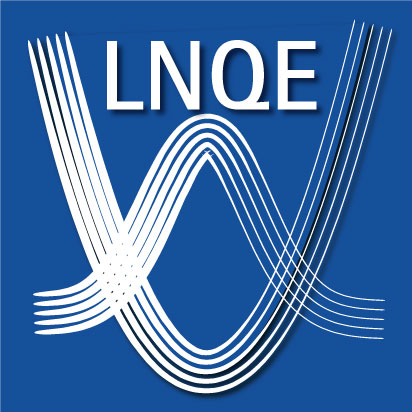Collaborating LNQE groups: B. Chichkov - C. Ospelkaus - T.E. Mehlstäubler
Author: Roman Kiyan
Summary. The development of commercial quantum computers and sensors is a primary goal in the growing field of quantum technologies. Quantum computing (QC) addresses classically unsolvable problems in optimization, quantum chemistry, life science, cryptography, and beyond. Quantum sensors (QS) and atomic clocks are used in navigation, communication and monitoring of geodetic heights. One of the most promising platforms for both applications are trapped ions, which are addressed and read out with laser light. For true scalability, ion traps with integrated photonics are needed that will allow hundreds of ions to be addressed. The integration of optical addressing is a formidable challenge with a complexity far beyond capabilities of a standard quantum technology laboratory. Within the BMBF project MIQRO (iQFab), an industrial-quality production line for the precise assembly of scalable, optically integrated ion traps is built at LNQE. This infrastructure will be part of a German quantum ecosystem supporting both innovative research projects and the technology transfer to industry.
Both QCs and QSs based on trapped ions are currently limited in the number of addressable ions due to the optical addressing by free space propagating laser beams. This type of optical addressing is not only very space-consuming and mechanically unstable, but also limits the ion trap geometries that can be implemented. Scaling up to hundreds of ions will only be possible through the integration of micro- and nano-photonic structures and the development of a highly innovative production line that covers all steps from pre-processing, precise assembly to contacting with the required accuracies of µm. At LNQE, we are developing a production line with which scalable ion traps for QC and QS can be manufactured and integrated with nano- and micro-optical elements. This includes laser welding capabilities, an automated optics alignment unit, metallization and bonding machines, and an fs-laser ablation system for free-form microfabrication. This will allow us to manufacture scalable ion traps in one place, to optimize the entire process with state-of-the-art machines and to implement photonic integration in ion traps. It will allow rapid prototyping for QC and QS and will be an ideal interface for knowledge transfer from research to industry in the field of ion traps with integrated photonic components.
At the heart of the assembly line is the ficontec CL1500 - photonics assembly machine, which provides the technology to precisely and automatically integrate the fabricated ion traps with a scalable fiber optic interface and other photonics components for optical addressing ion qubits. However, in order to exploit their capabilities, the array of technologies (Figure 1) must work in synergy as described below: a) The initial step in fabricating the ion traps is micromachining the ion trap chips from high performance dielectric materials. Fs-laser ablation is one of the most economical solutions to achieve the necessary micromachining qualities. A system designed for the production of ion traps is not commercially available and is therefore being developed using the fs-laser PH2-SP-20W-2mJ (Light Conversion, UAB) and a high-precision/fast 5D positioning system in combination with an adjustment table (Physikinstrumente (PI) GmbH & Co. KG.). Also at LNQE, an SLE (Selective Laser Induced Etching) machine purchaseded in frame of the MIQRO project is installed, which is ideal for structuring glass substrates of surface traps for through-hole plating and complex 3D structuring of glasses. b) The laser micromachined chips are metal coated using the most advanced, effective and robust industrial coating technologies, namely Ti/Au sputtering (HHV Ltd. coating equipment) and electroplating. c) Polarization-maintaining (PM) optical fibers are prepared for ion trap attachment using the Northlab Arc-Splicer. d) Integration of the precisely manufactured ion trap chips using the assembly system (ficontec CL1500) onto a photonic interface with sub-micron accuracy. e) Alignment and bonding together several chips. f) Electrical connection by means of thermosonic ball wedge bonding and chip bonding using the HB16 wire bonder (TPT Wire Bonder GmbH & Co.KG). g) Annealing under ultra-high vacuum (UHV) conditions using a special vacuum system and ion trap testing to ensure UHV compatibility.









